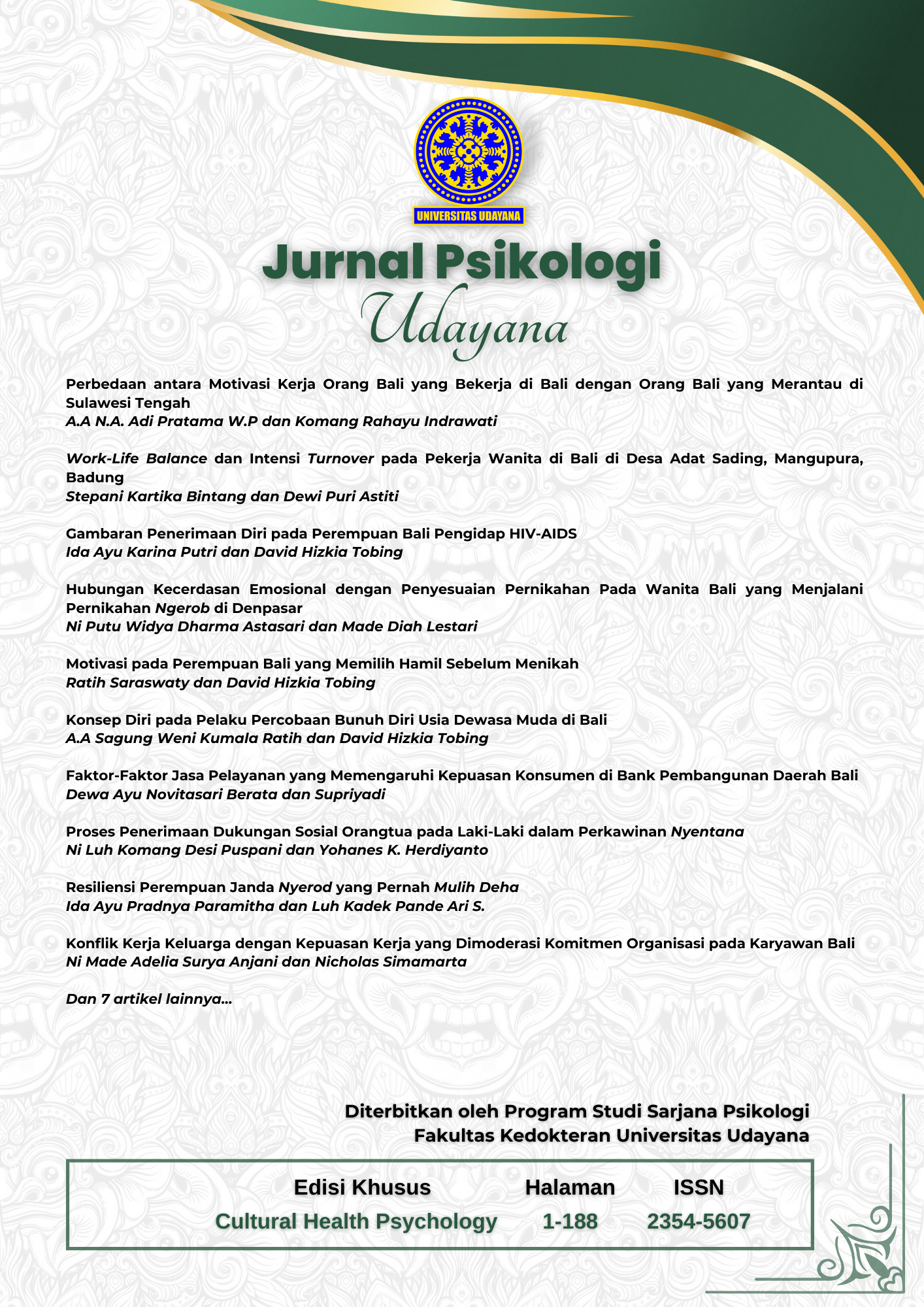GAMBARAN KUALITAS HIDUP PADA INDIVIDU YANG MENGALAMI KERAUHAN
Abstract
Quality of life’s aspect on every individual will be vary. One of the important experiences that may change Balinese’s people life is when they have an event called as kerauhan. Kerauhan is a term used to address a certain situation when someone is believed or taken as being possessed by a soul, other than the soul that has been living that body since it was born (Swadiana & Putrawan, 2006). There will be some changes occurred in someone’s life aspect which affects the achievements on their life by experienced kerauhan. Based on this, researchers wanted to know the picture of someone’s life-quality who experienced kerauhan.
The qualitative research method with phenomenological approach is used in this research to describe the aspects of life that got affected someone’s life who have experienced kerauhan. The data collection that is used in this research is an in-depth interview and observation which were examined toward 5 Balinese individuals of two categories. Individuals with a kerauhan experience based on intentional purposes such as ritual purposes, falls under the first category. While individuals who had an unexpected kerauhan, falls under the second category.
The result of this research shows that kerauhan doesn’t have a direct impact on someone’s life quality. But kerauhan can increase or decrease some aspects of someone’s life which at the end would change that person’s life into a better or even a disadvantageous one. Detailed result will be discussed under the context of the aspects of life that are affected by kerauhan.
Keyword: possession-trance, kerauhan, quality of life aspect, Balinese
Downloads
References
Apriyana, I. (2010, April 3). Memahami fenomena kesurupan pada siswa. Diakses dari Kompasiana.com: http://edukasi.kompasiana.com/2010/04/03/memahami-fenomena-kesurupan-pada-siswa/
Ardini, R. (2009). Persepsi wajib pajak terhadap kualitas pelayanan perpajakan pasca reformasi administrasi perpajakan pada kantor wilayah DJP Jawa Tengah I. Jakarta: Binus University.
Astiti, W. (2009, Maret 16). Misteri kerauhan (bagian-1). Diakses dari Kesehatan Harta Paling Berharga: http://rathikumara.blogspot.com/2009/03/misteri-kerauhan-bag-1.html
Basrowi, & Suwandi. (2008). Memahami penelitian kualitatif. Jakarta: Rineka Cipta.
Bogdan, & Taylor. (2004). In L. Moleong, Metodologi penelitian kualitatif (p. 4). Bandung: PT Remaja Rosdakarya.
Chiu, S. (2000). Historical, religious, and medical perspectives of possession phenomenon. Hong Kong Journal of Psychiatry, 14-18.
Cohen, E. (2008). What is spirit possession? Defining, comparing, and explaining two possession forms. Ethnos, 73:I.
Gunarya, A., Tamar, M., & Ibnu, I. (2010). Bersahabat Dengan Stress. Diakses dari http://repository.unhas.ac.id/bitstream/handle/123456789/34/10%20MD%2010%20-%20Bersahabat%20dengan%20stress.pdf?sequence=1
Gunawan, W. A. (2009, April 6). Memahami fenomena kesurupan dari sudut ilmu hipnoterapi. Diakses dari Pembelajar.com: http://www.pembelajar.com/memahami-fenomena-kesurupan-dari-sudut-ilmu-hipnoterapi
Indriani, N. (2013, January 23). Pengalaman murni: kesurupan kalau ada pohon besar. Diakses dari Detik Health: http://health.detik.com/read/2013/01/23/154733/2150842/775/pengalaman-murni-kesurupan-kalau-ada-pohon-besar?880004755
Klimo, J. (1998). Channeling: Investigations on receiving information from paranormal sources. California: North Atlantic Books.
Larasati, T. (2012). Jurnal kualitas hidup pada wanita yang sudah memasuki masa menopause.
Moleong, L. (2004). Metode penelitian kualitatif. Bandung: PT Remaja Rosdakarya
Monalisa. (2010). Gambaran kualitas hidup pada perempuan lajang lansia. Jakarta: Universitas Kristen Krida Wacana.
Nofitri, N. (2009). Gambaran kualitas hidup penduduk dewasa pada lima wilayah di jakarta. Jakarta: Universitas Indonesia
Nurlailah, N. (2010). Hubungan antara persepsi tentang dampak merokok terhadap kesehatan dengan tipe perilaku merokyarif hidayatullah jakartaok mahasiswa universitas islam negeri s. Jakarta: Universitas Negeri Islam Hidayatullah.
Pieter, Herri Zan, et al. (2010). Pengantar psikologi untuk bidan. Jakarta: Kencana Prenada Media Grup
Putrawan, N., & Swadiana, J. (2006). Kesurupan: Membahas tradisi kerauhan di Bali. Denpasar: Majalah Hindu Raditya.
Rubbyana, U. (2012). Hubungan antara strategi koping dengan kualitas hidup pada penderita skizofrenia remisi simptom. Jurnal Psikologi Klinis dan Kesehatan Mental, 59-66.
Sari, D. M., & Basri, S. A. (2007). Gambaran kecemasan dan depresi pada siswi yang pernah mengalami kesurupan massal. JPS VoL. 13 No. 02 , 111-125.
Schreurs, A. (2002). Psychotherapy and spirituality: Integrating the spiritual dimension into therapeutic practice. United Kingdom: Jessica Kingsley Publisher.
Shiraev, E., & Levy, D. (2012). Psikologi lintas kultural: Pemikiran kritis dan terapan moderen. Jakarta: Kencana.
Silitonga, R. (2007). Faktor-faktor yang berhubungan dengan kualitas hidup penderita penyakit parkinson di poliklinik saraf RS dr Kariadi. Diakses dari eprints.undip.ac.id/19152/1/ROBERT_SILITONGA.pdf
Spiegel, H. (2007). The neural trance: A new look at hypnosis. Journal of Clinical and Experimental Hypnosis, 387-410.
Springate, L. (2009). Kuda lumping dan fenomena kesurupan massal: Dua studi kasus tentang kesurupan dalam kebudayaan Jawa. Malang: Universitas Muhamadiyah Malang
Strauss, Anselm; Corbin, Juliet;. (2003). Dasar-dasar penelitian kualitatif (Kamdani ed.). (M. Shodiq, & I. Muttaqien, Trans.) Yogyakarta: Pustaka Pelajar.
Sugiyono. (2012). Metode penelitian kuantitatif, kualitatif, dan R&D. Bandung: Alfabeta.
Sutrisno, H., Dharmayuda, T., & Rena, R. (2010, Mei). Gambaran kualitas hidup pasien kanker limfoma non hodgkin yang dirawat di RSUP sanglah Denpasar (Studi pendahuluan). J Penyn Dalam, 11.
Swansburg, R. C. (2000). Pengantar kepemimpinan dan manajemen keperawatan untuk perawat klinis. Jakarta: EGC.
Taylor, S., Peplau, L. A., & Sears, D. (2009). Psikologi sosial. (F. Interpratama, Trans.) Jakarta: Prenada Media Group.
Authors who publish with this journal agree to the following terms:
- Authors retain copyright and grant the journal right of first publication with the work simultaneously licensed under a Creative Commons Attribution-ShareAlike 4.0 International License that allows others to share the work with an acknowledgement of the works authorship and initial publication in this journal.
- Authors are able to enter into separate, additional contractual arrangements for the non-exclusive distribution of the journals published version of the work (e.g., post it to an institutional repository or publish it in a book), with an acknowledgement of its initial publication in this journal.
- Authors are permitted and encouraged to post their work online (e.g., in institutional repositories or on their website) prior to and during the submission process, as it can lead to productive exchanges, as well as earlier and greater citation of published work (See The Effect of Open Access).













